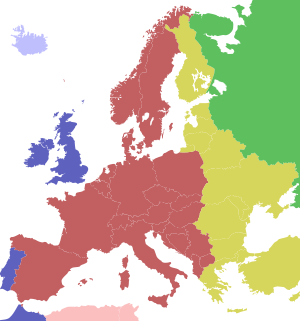- Central European Summer Time
-
 Time zones of Europe:
Time zones of Europe:
Light colours indicate countries that do not observe summer time: Algeria, Belarus, Iceland, Russia, Tunisia.blue Western European Time (UTC+0)
Western European Summer Time (UTC+01:00)light blue Western European Time (UTC+0) red Central European Time (UTC+01:00)
Central European Summer Time (UTC+02:00)yellow Eastern European Time (UTC+02:00)
Eastern European Summer Time (UTC+03:00)orange Further-eastern European Time (UTC+03:00) light green Moscow Time (UTC+04:00) Central European Summer Time (CEST) is one of the names of the Daylight saving time offset using the UTC offset of UTC+02:00, 2 hours ahead of Coordinated Universal Time. It is used as a summer daylight saving time in most European countries. During the winter, Central European Time (UTC+1) is used. Central European Summer Time may also be also known under other names, such as Middle European Summer Time (MEST), Central European Daylight Saving Time (CEDT) or 'Bravo time'.
Since 1996 European Summer Time has been observed between 1:00 UTC on the last Sunday of March and 1:00 on the last Sunday of October; previously the rules were not uniform across the European Union.[1]
Usage
The following countries and territories use Central European Summer Time.
- Albania, regularly since 1974
- Andorra, regularly since 1985
- Austria, regularly since 1980
- Belgium, regularly since 1980
- Bosnia and Herzegovina, regularly since 1983
- Bulgaria, regularly since 1979
- Croatia, regularly since 1983
- Czech Republic, regularly since 1979
- Denmark (metropolitan), regularly since 1980
- France (metropolitan), regularly since 1976
- Germany, regularly since 1980
- Gibraltar, regularly since 1982
- Hungary, regularly since 1980
- Italy, regularly since 1966
- Liechtenstein
- Luxembourg, regularly since 1977
- Malta, regularly since 1974
- Monaco, regularly since 1976
- Montenegro, regularly since 1983
- Netherlands (metropolitan), regularly since 1977
- Norway, regularly since 1980
- Poland, regularly since 1977
- Republic of Macedonia, regularly since 1983
- San Marino, regularly since 1966
- Serbia, regularly since 1983
- Slovakia, regularly since 1979
- Slovenia, regularly since 1983
- Spain (except Canary Islands), regularly since 1974
- Sweden, regularly since 1980
- Switzerland, regularly since 1981
- Vatican, regularly since 1966
CEST was used also in years 1993–1995 in Portugal and 1998–1999 in Lithuania.
See also
- European Summer Time
- Other countries and territories in UTC+2 time zone
- Other names of UTC+2 time zone
References
- ^ Joseph Myers (2009-07-17). "History of legal time in Britain". http://www.srcf.ucam.org/~jsm28/british-time/. Retrieved 2009-10-11.
Categories:- Time zones with daylight saving time
Wikimedia Foundation. 2010.
